
|
 |
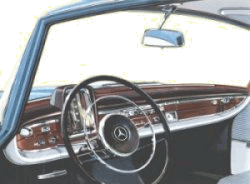 The new saloons offered a lot of advantages
for the Mercedes customers. The interior space became wider and although the roof was
lowered a couple of cm in comparison with the Ponton A, the interior space didn't suffer.
A lot of energy went into passive safety; in the 1960s this was a novelty. The new saloons offered a lot of advantages
for the Mercedes customers. The interior space became wider and although the roof was
lowered a couple of cm in comparison with the Ponton A, the interior space didn't suffer.
A lot of energy went into passive safety; in the 1960s this was a novelty. The dashboard was heavily padded and all the switches were made of
flexible material. Even the steering wheel had a padded central horn ring, while the
rearview mirror was designed to come off its mounting under impact and the windscreen to
pop out after a blow from inside the car. The amount of glass used was increased with 35%
so visibility was much improved. The deep windscreen and side windows made a contribution
to the underlying safety theme. To maintain better visibility in poor conditions, the
Heckflossen employed a new design of windscreen wiper which would come to characterize all
the Mercedes-Benz models of the 1960s; the new design had the arms of the wiper working in
opposing directions and overlapping in the middle of the screen so that the vertical edge
of the glass was almost fully cleared. |
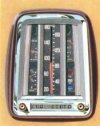 Not quite safe was the vertical strip-type
speedometer, which proved hard to read and was roundly criticized by the motoring-press
(this item wasn't found on later developed Coupes and Convertibles). More about this
speedometer in the next chapter. Not quite safe was the vertical strip-type
speedometer, which proved hard to read and was roundly criticized by the motoring-press
(this item wasn't found on later developed Coupes and Convertibles). More about this
speedometer in the next chapter. |
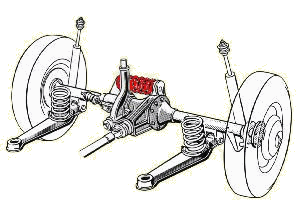 The structure of the new cars followed the
principles established with the Ponton saloons in its unitary construction with the engine
and front suspension mounted on a detachable subframe. The subframe was rather simpler in
design than the Ponton type. Front suspension was essentially the same as before, with
unequal-length wishbones and coil springs, although the track was wider, the dampers were
located further outboard, and an anti-roll bar permitted rather softer springing for an
American-style ride. This was matched by softer springs at the rear, where one swing-axle
was sprung against the other to prevent excessive roll by a horizontally-mounted coil
spring above the differential (here shown in red). The structure of the new cars followed the
principles established with the Ponton saloons in its unitary construction with the engine
and front suspension mounted on a detachable subframe. The subframe was rather simpler in
design than the Ponton type. Front suspension was essentially the same as before, with
unequal-length wishbones and coil springs, although the track was wider, the dampers were
located further outboard, and an anti-roll bar permitted rather softer springing for an
American-style ride. This was matched by softer springs at the rear, where one swing-axle
was sprung against the other to prevent excessive roll by a horizontally-mounted coil
spring above the differential (here shown in red).
|
 A very important safety feature was that
all the new saloons got a safety-cage with 'crumple zones'. The trunk had increased with
50%, this was not just simply because of styling but because of the need for a large
crumple zone at the rear. The Mercedes Heckflosse was the first production car in the
world to incorporate these safety principles. A very important safety feature was that
all the new saloons got a safety-cage with 'crumple zones'. The trunk had increased with
50%, this was not just simply because of styling but because of the need for a large
crumple zone at the rear. The Mercedes Heckflosse was the first production car in the
world to incorporate these safety principles. |
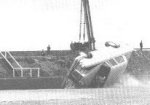 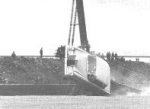 Mercedes
went quite far in testing these safety principles. The tests in those days were quite
spectacular in comparison with today's test. Often a steam rocket was used to propel cars
into a solid wall or into other vehicles. To examine the integrity of the safety cell a
Heckflosse was rolled through 180 degrees by launching it at a ramp at 80 km/h. Mercedes
went quite far in testing these safety principles. The tests in those days were quite
spectacular in comparison with today's test. Often a steam rocket was used to propel cars
into a solid wall or into other vehicles. To examine the integrity of the safety cell a
Heckflosse was rolled through 180 degrees by launching it at a ramp at 80 km/h. |
 A test that was less spectacular, but very useful,
was a head-on collision test, were a car is being propelled at about 50 km/h against a
solid wall (a test that is still used today). The 190 used here is another write-off, but
the front crumple zone has done its job and the passenger cell remains intact. Mercedes
used human-like dummies who could measure the impact of the collision. A test that was less spectacular, but very useful,
was a head-on collision test, were a car is being propelled at about 50 km/h against a
solid wall (a test that is still used today). The 190 used here is another write-off, but
the front crumple zone has done its job and the passenger cell remains intact. Mercedes
used human-like dummies who could measure the impact of the collision.
|
 The new saloons offered a lot of advantages
for the Mercedes customers. The interior space became wider and although the roof was
lowered a couple of cm in comparison with the Ponton A, the interior space didn't suffer.
A lot of energy went into passive safety; in the 1960s this was a novelty.
The new saloons offered a lot of advantages
for the Mercedes customers. The interior space became wider and although the roof was
lowered a couple of cm in comparison with the Ponton A, the interior space didn't suffer.
A lot of energy went into passive safety; in the 1960s this was a novelty.  Not quite safe was the vertical strip-type
speedometer, which proved hard to read and was roundly criticized by the motoring-press
(this item wasn't found on later developed Coupes and Convertibles). More about this
speedometer in the next chapter.
Not quite safe was the vertical strip-type
speedometer, which proved hard to read and was roundly criticized by the motoring-press
(this item wasn't found on later developed Coupes and Convertibles). More about this
speedometer in the next chapter. The structure of the new cars followed the
principles established with the Ponton saloons in its unitary construction with the engine
and front suspension mounted on a detachable subframe. The subframe was rather simpler in
design than the Ponton type. Front suspension was essentially the same as before, with
unequal-length wishbones and coil springs, although the track was wider, the dampers were
located further outboard, and an anti-roll bar permitted rather softer springing for an
American-style ride. This was matched by softer springs at the rear, where one swing-axle
was sprung against the other to prevent excessive roll by a horizontally-mounted coil
spring above the differential (here shown in red).
The structure of the new cars followed the
principles established with the Ponton saloons in its unitary construction with the engine
and front suspension mounted on a detachable subframe. The subframe was rather simpler in
design than the Ponton type. Front suspension was essentially the same as before, with
unequal-length wishbones and coil springs, although the track was wider, the dampers were
located further outboard, and an anti-roll bar permitted rather softer springing for an
American-style ride. This was matched by softer springs at the rear, where one swing-axle
was sprung against the other to prevent excessive roll by a horizontally-mounted coil
spring above the differential (here shown in red).  A very important safety feature was that
all the new saloons got a safety-cage with 'crumple zones'. The trunk had increased with
50%, this was not just simply because of styling but because of the need for a large
crumple zone at the rear. The Mercedes Heckflosse was the first production car in the
world to incorporate these safety principles.
A very important safety feature was that
all the new saloons got a safety-cage with 'crumple zones'. The trunk had increased with
50%, this was not just simply because of styling but because of the need for a large
crumple zone at the rear. The Mercedes Heckflosse was the first production car in the
world to incorporate these safety principles.
 Mercedes
went quite far in testing these safety principles. The tests in those days were quite
spectacular in comparison with today's test. Often a steam rocket was used to propel cars
into a solid wall or into other vehicles. To examine the integrity of the safety cell a
Heckflosse was rolled through 180 degrees by launching it at a ramp at 80 km/h.
Mercedes
went quite far in testing these safety principles. The tests in those days were quite
spectacular in comparison with today's test. Often a steam rocket was used to propel cars
into a solid wall or into other vehicles. To examine the integrity of the safety cell a
Heckflosse was rolled through 180 degrees by launching it at a ramp at 80 km/h.  A test that was less spectacular, but very useful,
was a head-on collision test, were a car is being propelled at about 50 km/h against a
solid wall (a test that is still used today). The 190 used here is another write-off, but
the front crumple zone has done its job and the passenger cell remains intact. Mercedes
used human-like dummies who could measure the impact of the collision.
A test that was less spectacular, but very useful,
was a head-on collision test, were a car is being propelled at about 50 km/h against a
solid wall (a test that is still used today). The 190 used here is another write-off, but
the front crumple zone has done its job and the passenger cell remains intact. Mercedes
used human-like dummies who could measure the impact of the collision.